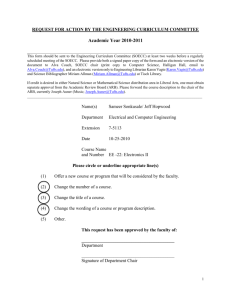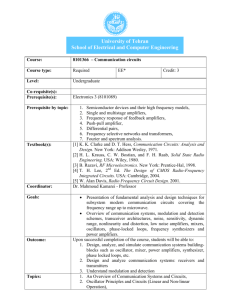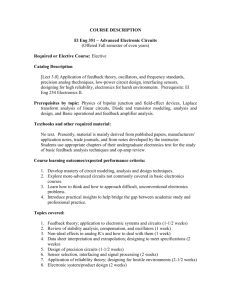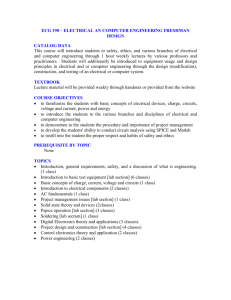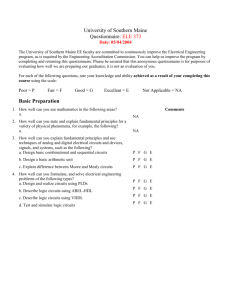Communication Circuits - EE0903521_syllabus
advertisement
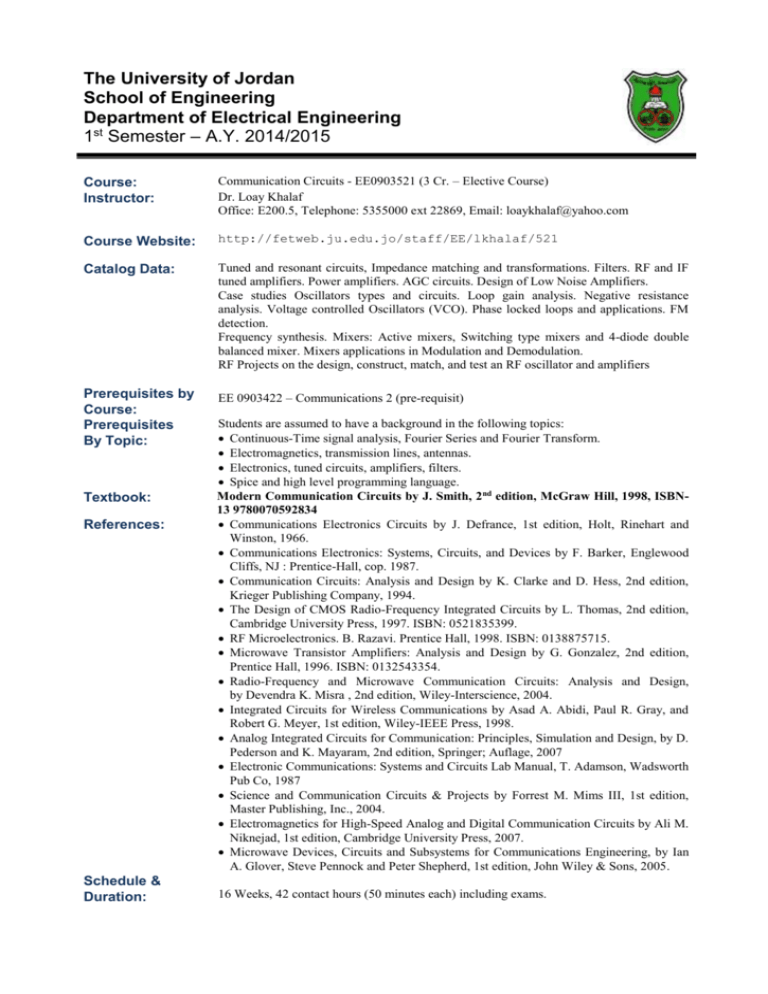
The University of Jordan School of Engineering Department of Electrical Engineering 1st Semester – A.Y. 2014/2015 Course: Instructor: Communication Circuits - EE0903521 (3 Cr. – Elective Course) Dr. Loay Khalaf Office: E200.5, Telephone: 5355000 ext 22869, Email: loaykhalaf@yahoo.com Course Website: http://fetweb.ju.edu.jo/staff/EE/lkhalaf/521 Catalog Data: Tuned and resonant circuits, Impedance matching and transformations. Filters. RF and IF tuned amplifiers. Power amplifiers. AGC circuits. Design of Low Noise Amplifiers. Case studies Oscillators types and circuits. Loop gain analysis. Negative resistance analysis. Voltage controlled Oscillators (VCO). Phase locked loops and applications. FM detection. Frequency synthesis. Mixers: Active mixers, Switching type mixers and 4-diode double balanced mixer. Mixers applications in Modulation and Demodulation. RF Projects on the design, construct, match, and test an RF oscillator and amplifiers Prerequisites by Course: Prerequisites By Topic: EE 0903422 – Communications 2 (pre-requisit) Textbook: References: Schedule & Duration: Students are assumed to have a background in the following topics: Continuous-Time signal analysis, Fourier Series and Fourier Transform. Electromagnetics, transmission lines, antennas. Electronics, tuned circuits, amplifiers, filters. Spice and high level programming language. Modern Communication Circuits by J. Smith, 2 nd edition, McGraw Hill, 1998, ISBN13 9780070592834 Communications Electronics Circuits by J. Defrance, 1st edition, Holt, Rinehart and Winston, 1966. Communications Electronics: Systems, Circuits, and Devices by F. Barker, Englewood Cliffs, NJ : Prentice-Hall, cop. 1987. Communication Circuits: Analysis and Design by K. Clarke and D. Hess, 2nd edition, Krieger Publishing Company, 1994. The Design of CMOS Radio-Frequency Integrated Circuits by L. Thomas, 2nd edition, Cambridge University Press, 1997. ISBN: 0521835399. RF Microelectronics. B. Razavi. Prentice Hall, 1998. ISBN: 0138875715. Microwave Transistor Amplifiers: Analysis and Design by G. Gonzalez, 2nd edition, Prentice Hall, 1996. ISBN: 0132543354. Radio-Frequency and Microwave Communication Circuits: Analysis and Design, by Devendra K. Misra , 2nd edition, Wiley-Interscience, 2004. Integrated Circuits for Wireless Communications by Asad A. Abidi, Paul R. Gray, and Robert G. Meyer, 1st edition, Wiley-IEEE Press, 1998. Analog Integrated Circuits for Communication: Principles, Simulation and Design, by D. Pederson and K. Mayaram, 2nd edition, Springer; Auflage, 2007 Electronic Communications: Systems and Circuits Lab Manual, T. Adamson, Wadsworth Pub Co, 1987 Science and Communication Circuits & Projects by Forrest M. Mims III, 1st edition, Master Publishing, Inc., 2004. Electromagnetics for High-Speed Analog and Digital Communication Circuits by Ali M. Niknejad, 1st edition, Cambridge University Press, 2007. Microwave Devices, Circuits and Subsystems for Communications Engineering, by Ian A. Glover, Steve Pennock and Peter Shepherd, 1st edition, John Wiley & Sons, 2005. 16 Weeks, 42 contact hours (50 minutes each) including exams. Minimum Student Material: Minimum College Facilities: Course Objectives: Textbook, class handouts, scientific calculator, and an access to a personal Computer with Spice. Classroom with whiteboard and projection display facilities, library, and computational facilities with Circuit Simulation program. The overall objective is to introduce the student to the basics of communications electronics. This course emphasizes: • Analog modulation and demodulation techniques. • RF Electronics. • Design and simulation of transmitter/receiver circuits. • Building RF transmitter/receiver circuits. Course Learning Outcomes and Relation to ABET Student Outcomes: Upon successful completion of this course, a student should: 1. Apply methods of amplitude, frequency, and phase modulation techniques. 2. Be able to analyze and identify AM and FM transmitters and receivers. 3. Perform circuit analysis of basic communication blocks (amps, oscillators, mixers, detectors). 4. Design basic communications blocks. 5. Model antennas and transistors. 6. Perform measurements including spectra and noise. 7. Perform complete system simulation of transmitters and receivers. 8. Provide system specifications for design. [a,e] [c,k] [a,e] [k] [a] [b,i] [a,c] [a,e] Course Topics: 1. 2. 3. 4. 5. 6. 7. 8. 9. 10. 11. 12. 13. 14. 15. Topic Description Resonant and Tuned circuits Impedance matching and transformation Noise and Noise figure Simulation, transient and small signal AC Small signal analysis of common amplifiers Frequency response of common amplifiers LNA (Cascode and feedback amp) Linearity and distortion (Intercept point, Compression, distortion) Antennas and transmission lines Oscillators Mixers Power amplifiers Detectors AM TX/RX FM TX/RX Hrs 3 3 3 3 6 3 3 2 1 3 3 2 4 3 3 Ground Rules: Attendance is required and highly encouraged. To that end, attendance will be taken every lecture. All exams (including the final exam) should be considered cumulative. Exams are closed book. No scratch paper is allowed. You will be held responsible for all reading material assigned, even if it is not explicitly covered in lecture notes. Assessments: Exams, Quizzes, Projects, and Assignments. Grading policy: First Exam Project / Assignments Midterm Exam Final Exam Total Last Updated: September 2014 10 % 10% 30 % 50 % 100%
